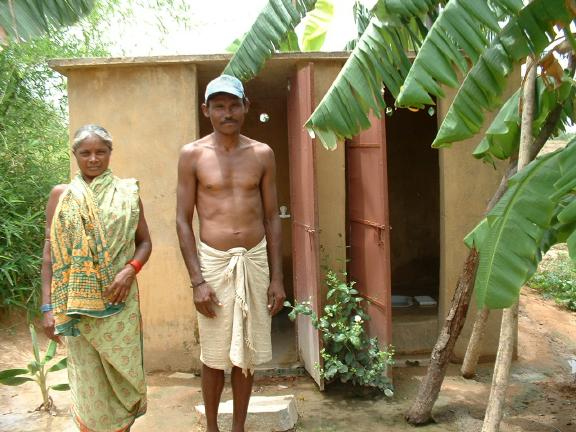
Gram Vikas: Building dignity, not just toilets
A dignified quality of life is not a prerogative of the wealthy and high caste people and equally the accidental birth to a lower social class should not condemn people to a life of exclusion, neglect, ill-health and indignity. Gram Vikas’ community based sanitation and water supply programme overcomes caste and gender discrimination to build toilets and bathing rooms, and provide running water supply. The result is stronger empowered communities, better health, more girls in school and economic independence.
Impact
Gram Vikas directly reaches out to 1,099 habitations with 66,561 families with a population of over 354,000 people.To date 943 healthy, educated, united and prosperous communities who have the skills and experience to resolve conflict, plan complex projects and challenge government representatives to deliver better quality services
Beneficiaries
Scheduled tribes, scheduled castes (Dalits, erstwhile untouchables) and other poor marginalised communities, and in particular the women in those communities
Sustainability
Gram Vikas has established a reputation for thoughtful productive rural development work. Their track record has proven that bottom up rural development is not only possible, but can be the key to living with dignity and hope.
In order to ensure the continued sustainability of MANTRA, Gram Vikas has built the credibility, relationships and human capital to successfully influence public policy locally and nationally.
Gram Vikas also involves entire communities and strengthens people’s organisations so that a critical mass of influencers can be mobilised for change. The expansion strategy aims to create a critical mass of people who are energised to seek their own development. Mobilising communities to influence local government bodies creates the momentum required to have the project owned and driven by government panchayat and block level. Also NABARD (The National Bank for Agriculture & Rural Development) has recognised the value of Gram Vikas model of sanitation & water supply and instructed, all nationalised banks to provide loans to families wanting to construct the Gram Vikas model of sanitation.
Innovation
Gram Vikas differs from others working in this sector in two key ways;
Firstly Gram Vikas’ model is a community-based model. Until and unless the entire community agrees to move forward the programme will not proceed. This is because without 100% inclusion, elimination of waterborne disease is not possible – just one person practicing open defecation can contaminate the water supply of the entire village. By insisting on 100% Gram Vikas supports the community to confront age-old practices of discrimination.
Secondly, the programme supplies water and sanitation while most others working in this field do only one or the other.
The specific innovative practices incorporated in the MANTRA model are 100% inclusion, cost sharing, community driven in terms of process innovation and technologically innovation in relation to induced gravity flow.
Scalability
The MANTRA programme is scalable in three key ways; expansion, replication and through networks of partners.
Expansion: Gram Vikas has proved that its projects are both scalable and replicable. To date 943 villages and 55,419 families have been reached, Gram Vikas’ longer-term aim is to reach 100,000 families in Orissa by 2016.
Experience has been that the project has a strong ‘Demonstration Effect’. When a village adopts the program and the impact is experienced, villages in the proximity express a desire to implement the project.
Replication: Although to date beneficiaries have been:
- chronically poor, (living on less than $1 a day)
- accustomed to practising open defecation for centuries,
- marginalised
- living in disunited communities
Gram Vikas’ experience shows they are willing to pay for quality water and sanitation services. From the current expansion it is apparent that the rural poor elsewhere will also do so.
Already the project has been replicated in other states in India and once appropriate partner orgSimilar geographical conditions prevail in many African countries; two recently started projects in Tanzania (with Camfed) and The Gambia (with Riders for Health) should demonstrate that the project can be replicated through independent organisations.
Partnering: Gram Vikas networks with and shares the MANTRA model with other NGOs in Orissa and further afield, frequently hosting exposure visits of villagers and delegation.
Source of funding
Gram Vikas finances its work from three main sources: Government grants, beneficiary contribution and grants & donations
In terms of sanitation, the average cost of a toilet and bathing room block per family is Rs. 16,000 of which Rs. 4,000 will be supported by Government as an incentive and social cost, Rs. 4,000 will be sourced as bank loan and Rs. 8,000 will be contributed by the individual household in the form of labour, material and some cash. If a family needs more assistance, it may take a bigger, longer-term loan.
Water supply is funded to the tune of approximately 80% by Government and the remainder is generally shared by the village community in the form of materials and labour.
In order to reach its goal of 45,000 more families by 2016, Gram Vikas will need to invest in personnel and implementation costs that would be around Rs. 5,000 per family. Therefore to scale up the model , additional funds from grants and donations required for 45,000 would be approximately Rs. 225,000,000 up to 2016